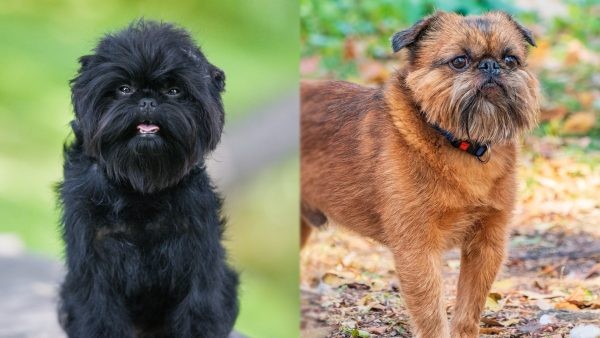
The Affenpinscher and Brussels Griffon, both toy breeds with distinctive monkey-like faces, present fascinating similarities yet notable differences that warrant careful examination. While the German-origin Affenpinscher was historically bred as a ratter, the Belgian Brussels Griffon was developed primarily as a companion dog. Despite their comparable small statures and wiry coats, these breeds differ significantly in temperament, maintenance needs, and behavioral traits. This comprehensive analysis explores their unique characteristics to help prospective owners make informed decisions about which breed might better suit their lifestyle and preferences.
Exercise and Activity Differences
Energy Level Requirements
While both breeds are active, they have distinct exercise needs. The Affenpinscher requires more daily exercise, needing around 40 minutes per day, compared to the Brussels Griffon's 30-60 minutes. The Affenpinscher tends to be more energetic and requires consistent physical activity to prevent behavioral issues. The Brussels Griffon prefers shorter morning walks followed by longer afternoon walks.
Wanderlust Tendencies
A key behavioral difference lies in their wanderlust potential. The Brussels Griffon has a strong tendency to roam and explore their surroundings, requiring secure leashing during walks. In contrast, Affenpinschers are more content staying within familiar environments and show less inclination to wander, making them better suited for homes without fenced yards.
History and Origins of the Affenpinscher and Brussels Griffon
Early Development and Purpose
The Affenpinscher originated in Germany during the 17th century, initially bred as skilled rat hunters for houses, barns, and granaries. Images of these dogs appear in paintings dating back to the 15th and 16th centuries, making them one of the oldest toy breeds. In contrast, the Brussels Griffon emerged from Belgium where they served as prized stable dogs. The breed was created by crossing Pugs, Affenpinschers and local stable dogs.
Breed Evolution
Originally, there were two sizes of Affenpinscher that excelled as ratters, though only one size remains today. The Brussels Griffon, while also depicted in 15th-century paintings, evolved primarily as a companion breed rather than a working dog. This key difference in their original purposes influenced their modern temperaments and characteristics.
Key Physical and Temperament Differences Between Affenpinscher and Brussels Griffon
Physical Distinctions
While both breeds are small, Affenpinschers stand slightly taller at 10-11 inches compared to Brussels Griffons at 7-8 inches. Affenpinschers have erect ears and a single coat, while Brussels Griffons feature floppy triangular ears and a double coat. The Affenpinscher's coat comes primarily in black or gray, whereas Brussels Griffons display more color variety including beige, tan, brown, blue and red.
Personality Contrasts
Affenpinschers tend to be more independent and less sensitive compared to Brussels Griffons. While both breeds are affectionate, Brussels Griffons are notably clingier and more vocal, with a tendency to bark frequently. The Affenpinscher is generally quieter and better suited for novice owners due to their eager-to-please nature, unlike the Brussels Griffon which can be more stubborn and challenging to train.
Health and Lifespan Comparison
Genetic Health Concerns
While Affenpinschers are prone to conditions like collapsed trachea, cataracts, and heart murmurs, Brussels Griffons face different health challenges including Chiari malformation, syringomyelia, and difficulties during birth due to puppy head size. The Brussels Griffon also has a unique sensitivity to the Leptospirosis vaccine that isn't present in Affenpinschers.
Grooming and Maintenance Requirements
Affenpinschers require less frequent bathing, needing it only every 8-12 weeks, while Brussels Griffons need bathing every 4-6 weeks due to their double coat. The Affenpinscher's single coat makes them more tolerant of warm weather compared to the Brussels Griffon. However, Brussels Griffons handle cold weather better, while Affenpinschers need extra protection in chilly conditions.
Conclusion
The comparison between Affenpinschers and Brussels Griffons reveals distinct differences in their physical characteristics, temperaments, and care requirements. While both are small companion breeds with historic ratting backgrounds, Affenpinschers tend to be slightly larger, more independent, and require more daily exercise (40 minutes) compared to Brussels Griffons (30-60 minutes). The Brussels Griffon is generally needier, more vocal, and has a stronger wanderlust tendency requiring secure containment.
Key practical differences emerge in their maintenance needs and health considerations. Affenpinschers have an advantage in grooming with their single coat requiring less frequent bathing, though they need more cold weather protection. Brussels Griffons require more frequent grooming but handle cold better. Health-wise, each breed faces unique challenges - Affenpinschers are prone to tracheal and cardiac issues, while Brussels Griffons can face serious neurological conditions and birthing difficulties. These differences suggest that potential owners should carefully consider their lifestyle, experience level, and ability to meet each breed's specific needs before making a choice.